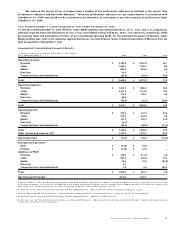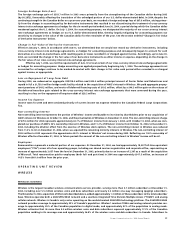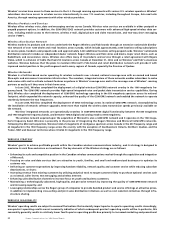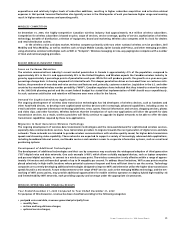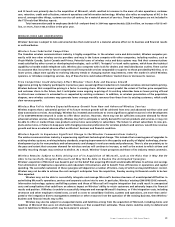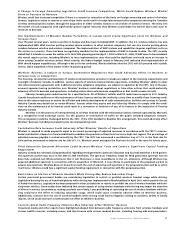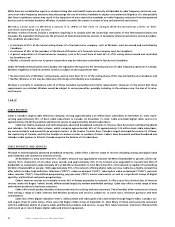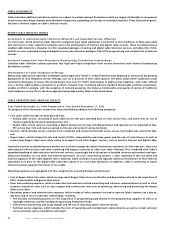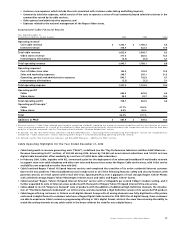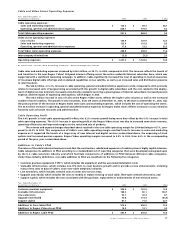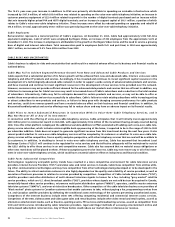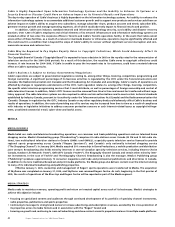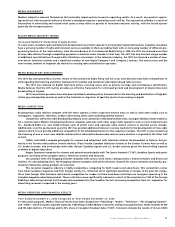Rogers 2004 Annual Report Download - page 33
Download and view the complete annual report
Please find page 33 of the 2004 Rogers annual report below. You can navigate through the pages in the report by either clicking on the pages listed below, or by using the keyword search tool below to find specific information within the annual report.
31
Rogers Communications Inc. 2004 Annual Report
A Change in Foreign Ownership Legislation Could Increase Competition, Which Could Reduce Wireless’ Market
Share or Decrease its Revenue
Wireless could face increased competition if there is a removal or relaxation of the limits on foreign ownership and control of wireless
licences. Legislative action to remove or relax these limits could result in foreign telecommunication companies entering the Canadian
wireless communications market, through the acquisition of either wireless licences or of a holder of wireless licences. The entry into
the market of such companies with significantly greater capital resources than Wireless could reduce its market share and cause its
revenues to decrease.
The Implementation of Wireless Number Portability in Canada Could Create Significant Costs for Wireless and
Increase Churn
Over the past several years, certain countries in Europe and Asia have mandated WNP. In addition, the U.S. wireless industry has also
implemented WNP. WNP involves porting wireless phone numbers to other wireless companies, but can also involve porting phone
numbers between wireline and wireless companies. The implementation of WNP systems and capabilities imposes significant costs on
the carriers in a country. There has been no regulatory mandate for the implementation of WNP in Canada to date. The CRTC recently
stated that it intends to review the matter in its 2005/2006 planning period (April 1, 2005 to March 31, 2006). If WNP were to be mandated,
this would require carriers, including Wireless, to incur implementation costs that could be significant and could cause an increase in
churn among Canadian wireless carriers. Most recently, the federal budget issued in February 2005 indicated that implementation of
WNP should happen expeditiously. Although it has yet to be confirmed, Wireless believes that the CRTC will still proceed with a public
review, albeit expedited, of this matter within its planning period.
Wireless’ Business is Subject to Various Government Regulations that Could Adversely Affect its Business or
Increase Costs or Competition
The licencing, construction and operation of wireless communications systems in Canada are subject to the licencing requirements and
oversight of Industry Canada. In addition, various aspects of wireless communications operations, including Wireless’ ability to enter
into interconnection agreements with traditional wireline telephone companies, are subject to regulation by the CRTC. Any of the gov-
ernment agencies having jurisdiction over Wireless’ business could adopt regulations or take other actions that could materially
adversely affect its business and operations, including actions that could increase competition or that could increase its costs.
Industry Canada grants radio licences for a specified term. All of Wireless’ cellular and PCS radio licences expire in 2011. Industry
Canada has placed conditions on the maintenance of these licences and has the authority at any time to modify these licencing condi-
tions to the extent necessary to ensure the efficient and orderly development of radio communication facilities and services in Canada.
Industry Canada may decide not to renew Wireless’ licences when they expire and any failure by Wireless to comply with the condi-
tions on the maintenance of its licences could result in a revocation or forfeiture of any of its licences or the imposition of fines by
Industry Canada.
Wireless is in the process of interconnecting its wireless network with the telecommunications network operated by Microcell,
as a competitive local exchange carrier, for the purpose of termination of traffic on the public switched telephone network.
This arrangement could be challenged before the CRTC. If the CRTC decided to disallow this arrangement, this could adversely affect
Wireless’ business, including increased income tax and operating costs.
Contribution Rate Increases Could Adversely Affect Wireless’ Results of Operations
Wireless is required to make payments equal to an annual percentage of adjusted revenues in accordance with the CRTC’s revenue-
based contribution scheme to a fund established to subsidize the provision of basic local service in high cost regions. The percentage of
adjusted revenues payable is revised annually by the CRTC. The CRTC has announced a contribution levy of 1.1% as the final rate for
2004 and has announced an interim rate for 2005 of 1.1%. Wireless cannot anticipate the final rate for 2005 or the rates for future years.
Third Generation Spectrum Allocation Could Increase Wireless’ Costs and Create a Significant Capital Funding
Requirement
Industry Canada has released a proposed policy regarding third generation spectrum allocation and has indicated that a third genera-
tion spectrum auction may occur in the 2005 to 2006 timeframe. The spectrum frequency range for third generation spectrum has not
been fully resolved, but Wireless believes that it will likely bear a close resemblance to the U.S. allocation. Although Wireless has
acquired additional spectrum in connection with its acquisition of Microcell, it may choose to participate in the proposed auction to
acquire new spectrum. Wireless does not know how much the cost of acquiring such spectrum in the proposed auction will be or when
it will occur. Wireless could face a significant capital funding requirement in connection with this proposed auction.
Restrictions on the Use of Wireless Handsets While Driving May Reduce Subscriber Usage
Certain provincial government bodies are considering legislation to restrict or prohibit wireless handset usage while driving.
Legislation banning the use of hand-held phones while driving was implemented in Newfoundland in April 2003, which permits the use
of hands-free devices. Legislation has been proposed in other jurisdictions to restrict or prohibit the use of wireless handsets while dri-
ving motor vehicles. Some studies have indicated that certain aspects of using wireless handsets while driving may impair the attention
of drivers in various circumstances, making accidents more likely. Laws prohibiting or restricting the use of wireless handsets while dri-
ving could have the effect of reducing subscriber usage, which could cause a material adverse effect on Wireless’ business.
Additionally, concerns over the use of wireless handsets while driving could lead to litigation relating to accidents, deaths or bodily
injuries, which could also have a material adverse effect on Wireless’ business.
Concerns About Radio Frequency Emissions May Adversely Affect Wireless’ Business
Occasional media and other reports have highlighted alleged links between radio frequency emissions from wireless handsets and
various health concerns, including cancer, and interference with various medical devices, including hearing aids and pacemakers.


